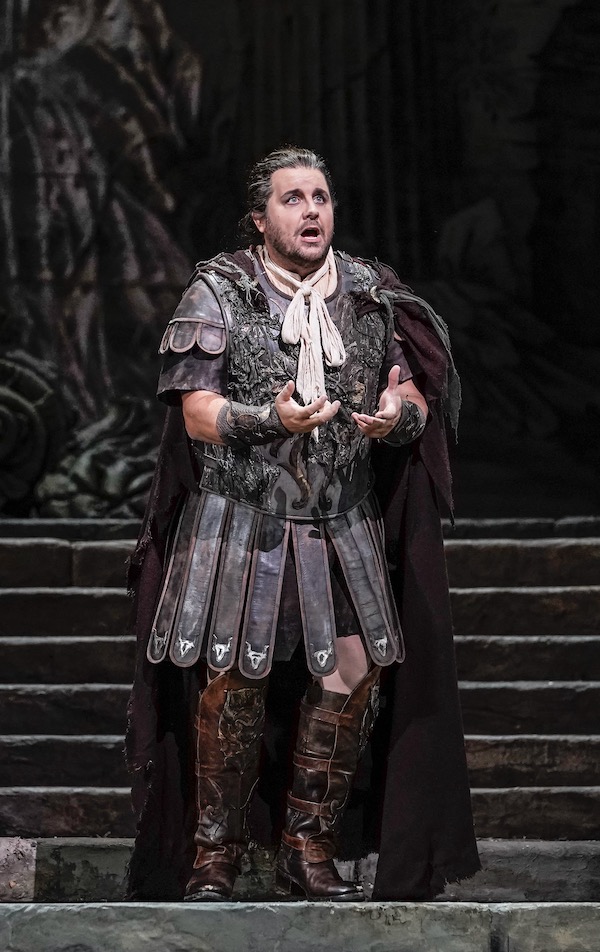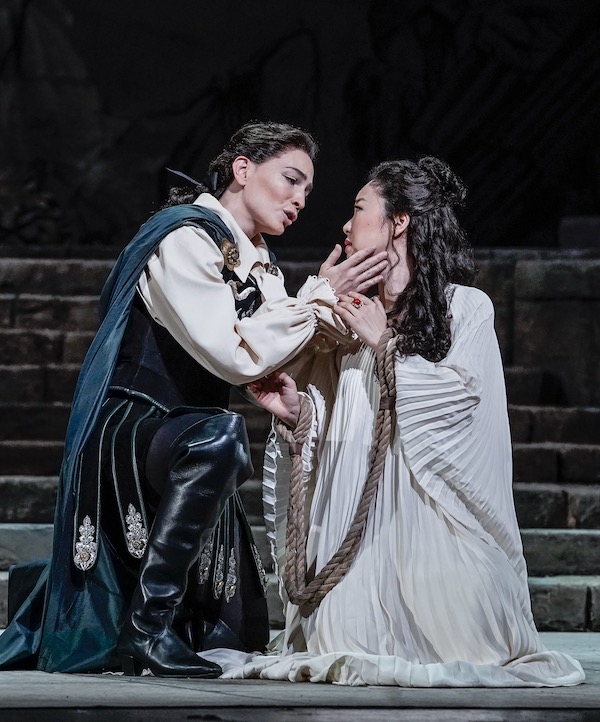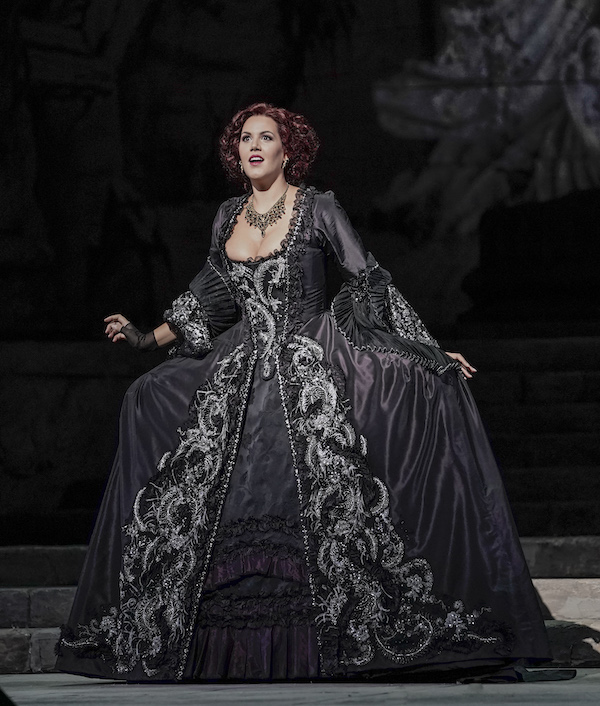Honeck and a sterling Met cast bring luminous grace to Mozart’s “Idomeneo”

The Metropolitan Opera revived Jean-Pierre Ponnelle’s 1982 production of Mozart’s Idomeneo for the second night of the new season.The late French opera director, set and costume designer courted controversy at times, but tor the first-ever production of the Mozart opera at the Met, he stuck to the book.
Some of the greatest opera stars of the past forty years have appeared in the production. Less starrier names are in this revival, but perhaps few casts have brought such youthful grace and lovely lyrical singing to Mozart sublime melodies as does this one. Equally important were the much-anticipated house debut of conductor Manfred Honeck and tenor Michael Spyres’ return to the Met in the title role.
Mozart was only 24 years old when he composed Idomeneo.The opera is set on the island of Crete and is one of the many stories arising from the aftermath of the Trojan War. Its plot centers on the vow of Idomeneo, the King of Crete, to offer a human sacrifice to Neptune in gratitude for his safe return to his kingdom. Gods and fate being fickle, that unfortunate person is his son Idamante. The king refuses to kill his son, deciding to banish him instead, for which the gods exact revenge on the island.
There is also a love triangle, as Idamante is captivated by the Trojan princess Ilia, whom he has rescued from a storm, as well as the object of the passions of Elettra, daughter of Agamemnon and Clytemnestra. The tender love between Ilia and Idamante, however, moves Neptune to spare the life of Idamante, who becomes king upon his father’s abdication.
Ponnelle took no directorial liberties in this staging of Idomeneo; if anything it was a bit old-fashioned even by the standards of the day, especially the rather static placement of the principals and chorus, who often stand stock still. The sets, comprised of columns and painted backdrops in sepia tones, are faithful depictions of classical scenes from antiquity. A massive bust of Neptune dominates the stage at key moments. The only injection of levity, whether intentional or not, was the opening of Neptune’s stone eyelids when the god speaks at the end of the opera, which elicited a few laughs at this performance.
The production does provide an ideal setting, however, for the music to take center stage and Honeck led a performance that was particularly light and lyrical. Mozart’s beautiful melodies unfolded seamlessly, creating an almost trancelike effect. None of the drama or intensity of the score was lacking, but it was a performance on a particularly intimate scale. If Honeck returns to the Met, undoubtedly another facet of his musical personality will be revealed, but for his impressive debut, he proved to be a Mozartean of rare refinement.
Tenor Michael Spyres made his Met debut in 2020 in Berlioz’s La Damnation de Faust and has had considerable success in major European houses, primarily in lyrical roles. The Missouri-born singer has a most unusual voice due to the extremeness of its range; he is often promoted as that rara avis, a baritenor. Apart from a few particularly rich descents into the lower realms of his voice, however, Spyres was in full tenor mode as Idomeneo.
The staging precludes almost all grand physical displays of passion, but Spyres commanded attention and authority with his voice. He captured the nobility of a king and the complexities of a father who has unintentionally brought about the impending death of his son. He explored all of Idomeneo’s conflicted emotions in a bravura account of “Fuor del mar,” in which the king wonders whether that he is as at much personal risk ashore in his own kingdom, as he was shipwrecked at sea.

Mezzo-soprano Kate Lindsey was a noble and dignified Idamante. In appearance, Lindsey embodied a young man conflicted by filial duty and romantic love . Her voice is light, but carried effortlessly into the theater. For all of its beauty, some of the most effective moments where when she shed all color and vibrato from her voice to express sorrow or despair. Lindsey’s singing of Idamante’s two great arias, “No, la morte” and “Non ho colpa”, were spellbinding, but her best moments came in Idamante’s duet with the Ilia of Ying Fang, “S’io non moro a questi accenti.”
Fang was a vision of demure loveliness whether attired in a flowing white, pleated dress, or a more sumptuous champagne-colored gown. A singer of exceptional poise and elegance, Fang possesses a clear and limpid lyric soprano voice and adorned Mozart’s melodies with effortless, enchanting coloratura. Her abundant gifts were shown to full effect, however, in “Zeffiretti lusinghieri”, in which she bids the Zephyrs tell Idamante of her love for him.
As Elettra, soprano Federica Lombardi was the embodiment of glamour in her monumental late-eighteenth century gown. The beauty of her voice and refinement of her singing were on par with that of any singer on stage. Apart from Elettra’s frequent lapses into rage, Lombardi created an almost sympathetic portrait of a deranged woman scorned in love. Her meltdown aria “Oh ! Smania …. D’oreste e d’Aiace”—one of the greatest rage arias ever composed—was sensational, vividly reflecting the moment when Elettra perceives herself to be abused and betrayed by all. Exhausted by her torrential outbursts of anger, Lombardi’s Elettra collapsed on stage, only to be unceremoniously carried off stage by several hearty men.
Tenor Paolo Fanale displayed a fine lyric tenor voice in a compassionate portrayal of Idomeneo’s confidant, Arbace. As the High Priest, Issachah Savage charged onto stage with enormous energy and presence, with a commanding voice to match.
In Idomeneo, Mozart wrote choral music that is perhaps unequalled in any of his other operas. The Met chorus sang splendidly. Most impressive were the men in “Pieta! Numi, Pieta!”, or the Sailor’s Chorus. The Met orchestra too was peerless in responding to Honeck’s delicate, but authoritative touch. Seldom has the orchestra sounded more luminous and transparent than it did under Honeck’s baton.
Idomeneo continues until October 20. metopera.org




Posted Oct 07, 2022 at 1:53 pm by Tom Fedorek
Saw it last night. Terrific singing all around.
I too was struck by how frequently Kate Lindsey turned off the vibrato. Since Idamante was originally a castrato role, I wondered if she might be trying to reproduce the effect of boy soprano vocal chords powered by grown-up lung capacity.